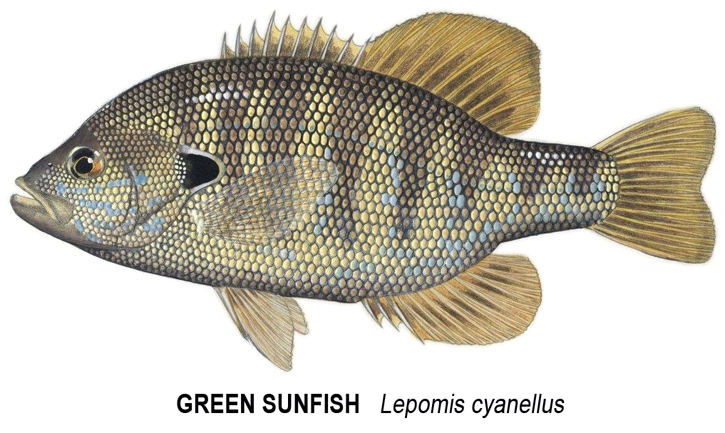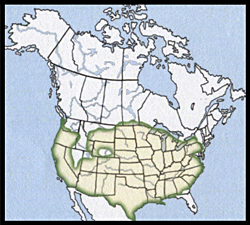Green Sunfish, August 2014, Fish of the Month!
A Brief Note to Our Readers:
A brief note about this family of Fishes: The Sunfish family includes a large number of very North American species. We're including many of them here (in spite of their often small size) because they make excellent warm-water training species for young anglers and because adult warm-water fly-fishers are likely to often take them as incidental catches and would like to know what species they've brought to hand.
 Green sunfish
Green sunfish
Lepomis cyanellus
Local Names:
Black perch, Buffalo sunfish, Green perch, Rock bass, Blue bass, Branch perch
Average Size:
5 to 7 inches
Distinguishing Field Marks:
(See the illustration.)
-
The body is thicker (less "slab-sided") than those of the other small sunfishes.
-
Compared to most of the smaller Sunfishes, the head of this species is quite large, with a large eye.
-
The opercular (ear) flap is conspicuous, with a black center bordered with cream or white.
The mouth is large for this genus (Lepomis), with the upper jaw extending back to the mid point of the eye.
The first dorsal fin usually has 10 spines and is completely joined to the second.
The caudal (tail) fin is slightly forked.
The pectoral fins are large.
North American Range:
Map to the right shows approximate range in North America.
Diet:
Aquatic invertebrates, especially immature insects and mollusks.
Biology:
In late spring and into full summer, male Green sunfish claim territories in shallow sunlit water where they open one or two nests in crowded colonies. Females are actively courted by males when they appear at the nest colony and spawning takes place over a period of 1 to 2 days. Spawning is accomplished with the female turned on her side and the male in an upright stance as the pair vibrates over the nest. Females will spawn with multiple partners until their eggs are spent. Males remain at the nest to fan and guard the fertilized eggs which hatch in 3 to 5 days, and continue to protect the newborn young for a short period.
Adult Green sunfish are not fussy about their habitats. Being tolerant of mildly compromised water quality, and some turbidity, Green sunfish thrive in the shallows of lakes ponds, the slower portions of larger rivers, and even large streams.
Fly Fishing for Redbreast Sunfish:
Although its native range was once restricted to the east-central regions of the United States, this species is presently widely distributed throughout the U.S. and a bit of southern Canada.
Green sunfish are found in typical shallow-water "pan-fish" habitats, often around emergent vegetation. Like its close kin, the Green sunfish is not likely to be actively sought by visiting anglers, and is most frequently caught by youngsters having some local fishing fun. We include it here, in part, because if you are fishing for sunfish within its range, you're likely to catch some. This sunfish's appearance is different enough from that of both Bluegills and Pumpkinseeds that it might cause you to wonder, "What is this?"
Your favorite small fish fly angling gear is first choice for this species. A 4 or 5 weight outfit with a matched floating line is perfect. And, typical of these small sunfishes, the Green sunfish is a willing taker of both surface and sub-surface flies. Wooly Worms, Gray and Brown Hackle Peacock wet flies, small Wooly Buggers, also of assorted colors, and assorted buck-tail streamers on small hooks are first choices for sunken presentations. Cooper Bugs (Devil Bugs) in a wide range of colors, foam beetles and ants, and small bright or dark cork or spun and clipped deer hair poppers are ideal for surface work.
Always crush the barbs on your hooks with a pair of needle-nose pliers to make releasing (and hooking) the majority of your fly caught fish an easy job.
Because of its diminutive size, this is another of our native species that is usually overlooked as a food fish, but is one that can, when properly prepared, provide the same high quality "fish fry" meals as the other members of its family.
Small Green sunfish are also well suited for keeping in a large, attentively maintained home aquarium.
Significance to Humans:
Minor, except as a forage species for large fishes with which it shares communal waters (typically bass and pike), and another of this family that can provide youngsters (and adults) with hours of fly-fishing pleasure.
Status:
Maintaining, thriving.






